Welcome to the
Web-based Video Workbook
for
The Concurrent Engineering
Video Programs Vol. 19 & 20,
on Video Tapes 19 & 20, or on Digital Video CD-ROMs
for Engineering, Computing and Management Students and Professionals, as well as the
Custom CD-ROM
by
Paul G Ranky, Dr.-techn / PhD
Written and presented by Dr. Paul G. Ranky and Industrial Contributors, including Mr. R. B. Syme, IBM Storage Products Operations Manager, Mr. Gerry Edgar, Manager, Mr. Chris Skerry, CIM Manager, Mr. Peter Neal and Mr. Mike Moulton, Managers, IBM Havant (UK) Ltd, Mr. Robin Truman, CIM Operations Manager, GPT, Mr. John Foster and Mr. Carlton McD Langton, Industrial Design and Realisation, GPT-GEC Plessey Telecommunications Ltd, Mr. Paul A. Francis, Director, International CIM Consultants, Dr. Allan Parker, Technical Director, Mr. Mark Vaux, Mr. Mark Sealy, Mr. John Halton and Mr. Roy Davis, Managers, Lucas Engineering & Systems Ltd, Mr. Les Pratt, Marketing Manager, Yamazaki Machinery (UK) Ltd, Mr. Geoff Harrington, Director, ISIS Informatics Ltd, Mr. Jim Corlett, BKT Ltd, McDonnell Douglas Information Systems Ltd, ERT Ltd, Hitachi Seiki (UK) Ltd and others.
Published by CIMware Ltd. UK and CIMware USA, Inc. at http://www.cimwareukandusa.com, © Copyright by CIMware Ltd. UK and CIMware USA, Inc., 1999 - 2000.
If you are a viewer of a legitimate copy of
the above video programs on tapes or on CDs, please feel free to view
and / or download this workbook, with its full contents, FREE of charge, but always mention the website: http://www.cimwareukandusa.com and the author(s) as the source!
Website: http://www.cimwareukandusa.com
Optional on-line email support: cimware@cimwareukandusa.com
Go to Welcome Page
Please use this Workbook together with your Video Tapes or Video CDs!
Please note, that the digital video quality on the CD-ROMs is high and can play in full screen on a multimedia PC, MAC or Unix machine. The video frame images inserted into this workbook are designed to download relatively fast over the average web-link, therefore their quality is poorer than that of the digital videos in the CD-ROMs.
This section covers the following:
Tape/Vol. 19:
Concurrent Engineering and Total Quality Management: the IBM Case Study
Tape/Vol. 20: Concurrent Engineering and Quality Management Experiences ... A Brutally Honest Overview with Examples by IBM Guru Gerry Edgar and Robin Truman, GPT
Custom CD: Unique in Each Video CD Pack, Containing Multimedia Web-objects for Further Analysis.
 Additional
reading on Object Oriented Concurrent (hardware and software)
Engineering: as a new development, view the free, electronically
published R&D journal, ADAM with IT
(Advanced Design And Manufacturing with Information Technology) at
this web site, as well as enjoy the hotlinks to other web sites via
ADAM's WebCorner; both just a click
away...
Additional
reading on Object Oriented Concurrent (hardware and software)
Engineering: as a new development, view the free, electronically
published R&D journal, ADAM with IT
(Advanced Design And Manufacturing with Information Technology) at
this web site, as well as enjoy the hotlinks to other web sites via
ADAM's WebCorner; both just a click
away...
Tape/Vol. 19. Starts Here: Concurrent Engineering and Total Quality Management: the IBM Case Study
Concurrent Engineering and Total Quality Management: the IBM Case Study is discussed by Mr. Gerry Edgar, Manager, IBM UK. Topics in this industrial case study include the following:
- CE and TQM: the IBM case study on product business review and
Manufacturing Early Involvement (MEI)
- Planning, process fine tuning and process comission
- Focus team activities
- MCA-Manufacturing Competitive Analysis
- Methods, tools and case studies
- Performance, cost quality and reliability
- Justification of TQM and CE
- Process and performance charts
- New product introduction cycle charts and the transfer
point
- Competitive analysis, business and technology skills
- The importance of education
- Interactive team and/or individual exercises.
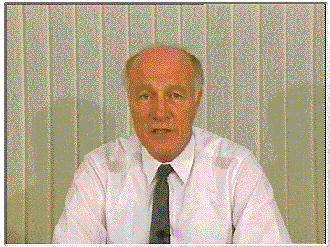
When wieving this program, try to imagine that you are a member of
this collaborative concurrent engineering team. As you can see, there
are several different engineering, manufacturing, total quality,
information technology/ computing science, marketing, management and
other expertise represented in such teams.
The relationship between product,
manufacturing early involvement (remember, this is the IBM term
for CE), production engineering and MCA (Manufacturing Competitive Analysis). (A conceptual figure after IBM, explained by
Mr. G. Edgar, IBM).
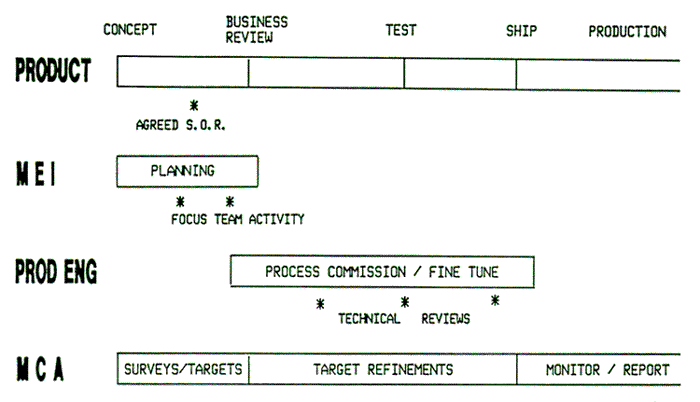
A process chart. An excellent method for analyzing multi-disciplinary process competitiveness...
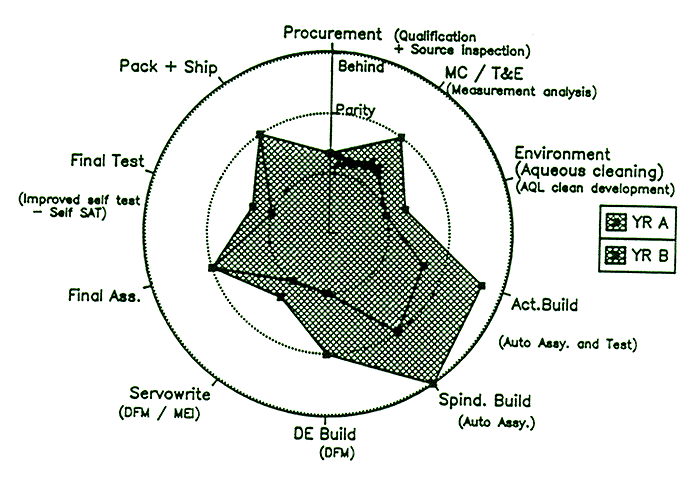
A performance chart. An excellent method for analyzing multi-disciplinary performance competitiveness...
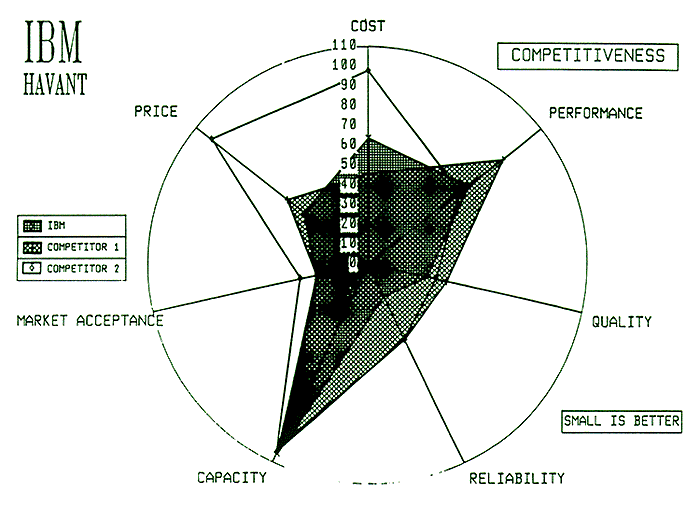
As interactive team and/or individual exercises discuss total quality and concurrent engineering:
- What are the information system components?
- What are the components (objects and classes of objects) of
process charts and how are they used? Could you apply this
excellent and very simple method in your own organization?
How?
- What are the components (objects and classes of objects) of
performance charts and how are they used? Could you apply this
excellent and very simple method in your own organization?
How?
- List some strategically important issues discussed, as well as
how they might relate to your business?
Jump To Top
The analysis of the product transfer point in the new product cycle chart...
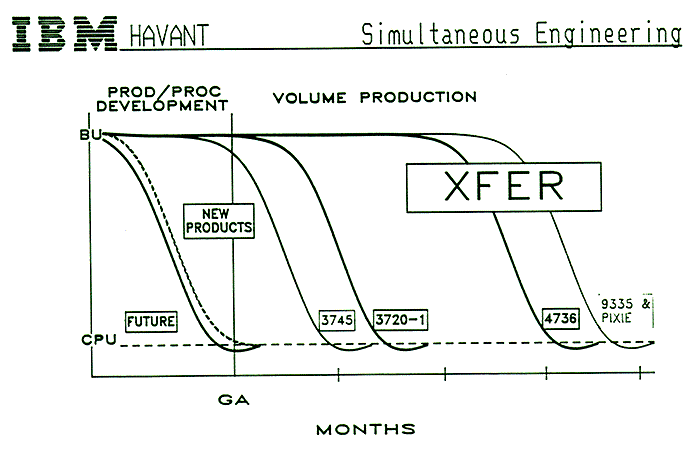
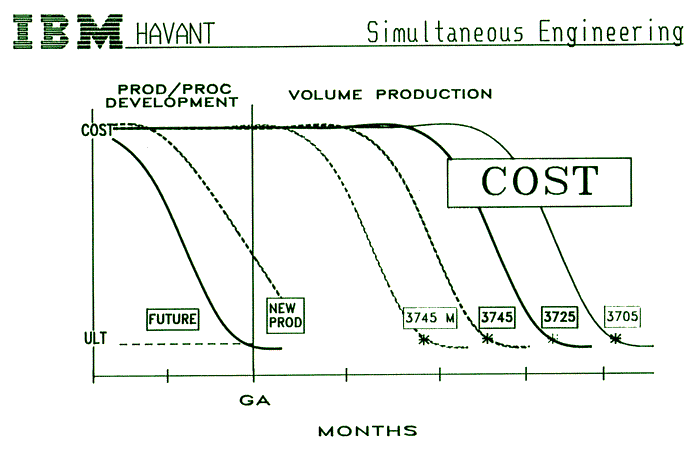
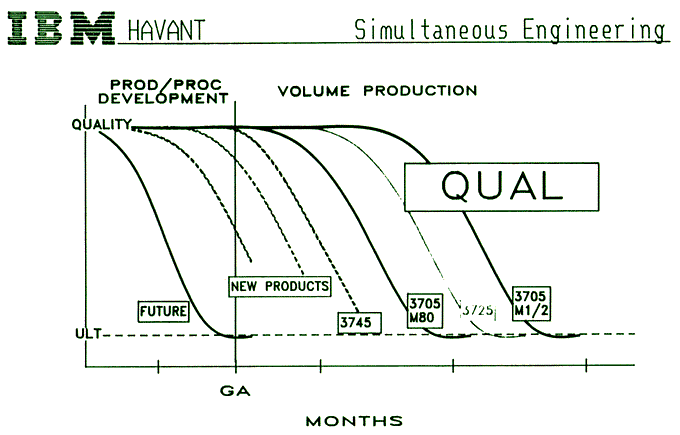
As interactive team and/or individual exercises discuss total quality and concurrent engineering in the following context:
- Product and process development
- Point of transfer to GA
- Product quality and the related cost
- The long term financial benefits
Jump To Top
MEI (Manufacturing Early Involvement) Improvements...(Note, that the latest statistical data is not shown for confidentiality reasons, nevertheless the educational value of this presentation does not suffer because of this).

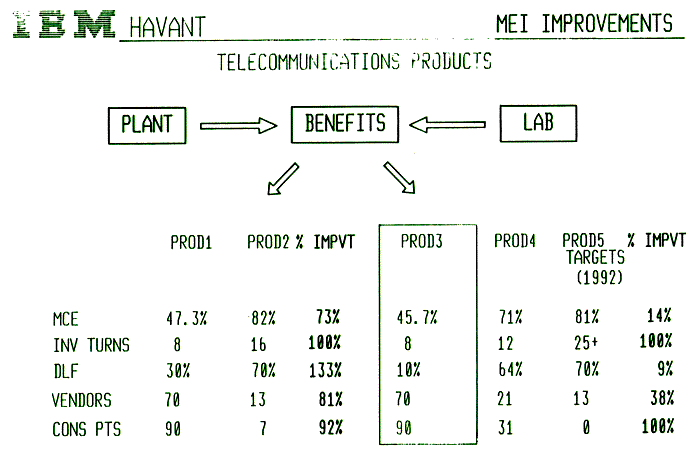
As interactive team and/or individual exercises discuss machine cycle efficiency in the following context:
- Inventory turns...
- Direct Line Feed (DLF)...
- Vendors...
- Consined parts...
Jump To Top
Education in multidisciplinary subject areas, including design, manufacturing, total quality, IT, financial and project management and others is critical...(Note, that the latest IBM data is not shown for confidentiality reasons)
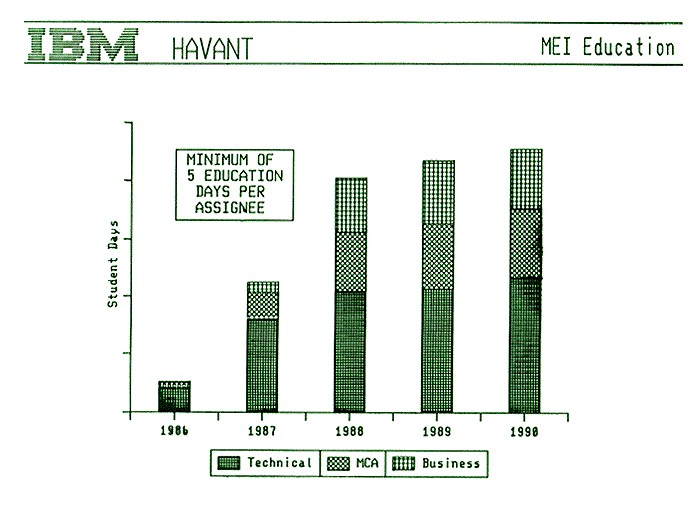
As interactive exercises discuss your own education process in the "life-long-learning" context:
- List your existing as well as the desired critical skills you
should have. Make sure, that precedence rules are followed at
least in broad terms
- Reason over your own education issue yourself. Try to answer
the question: "Where do I want to be in 3 or 5 or 10 years
time?
- Besides the above, seek advice from somebody you trust at
home, and/or at work, and/or at the university on your next 3 to 5
year plan, as well as the next 5 to 10 year plans... Do you know
the way you are heading?... or just drifting with the current...
THEN, and only then create a plan that you frequently (e.g.
monthly, yearly) review. Is there a need to adjust your plan? If
yes, how? What is realistic and why?
- Keep in mind: nobody else but you can take the final
decision!
Jump To Top
*********************** End of Tape 19 ***********************
Tape/Vol. 20. Starts Here: Concurrent Engineering and Quality Management Experiences ... A Brutally Honest Overview with Examples by IBM Guru Gerry Edgar and Robin Truman, GPT
Concurrent Engineering and Total Quality Management: the IBM Case Study is discussed by Mr. Gerry Edgar, Manager, IBM UK. Topics in this industrial case study include the following:
- Concurrent engineering management experiences... a brutally
honest overview with examples by IBM guru: Gerry Edgar
- A summary of the most important methods, tools, technologies
and strategic focus items
- Delegation, faith and trust
- How can one delight the customers
- The "total and systematic" picture
- Team creation and management; Leadership and vision
- Team problem solving methods and examples
- Team pressures and responsibility sharing
- Concurrent engineering investments and benefits for small and
large cooperations
- Tactical versus strategical decisions
- Japanese and Western techniques
- Interactive team and/or individual exercises.

When wieving this program, try to imagine that you are a member of
the concurrent engineering team. As you can see, there are several
different engineering, manufacturing, total quality, information
technology, marketing and other expertise represented in such
teams.
Back to quality and all the good staff discussed earlier about inspection, process control, product development and others, but this time from a management point of view...
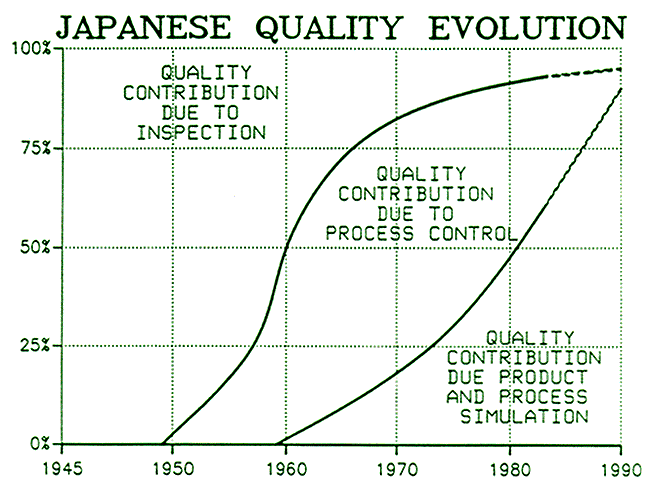
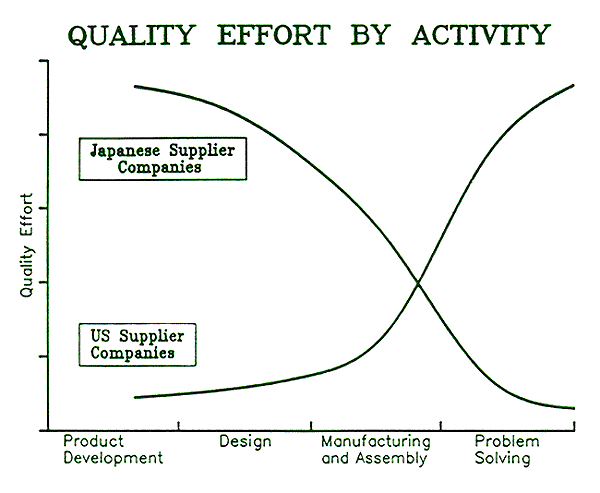
Note, that the latest statistical data is not included here due to confidentiality...This, however does not reduce the education value of our discussion.
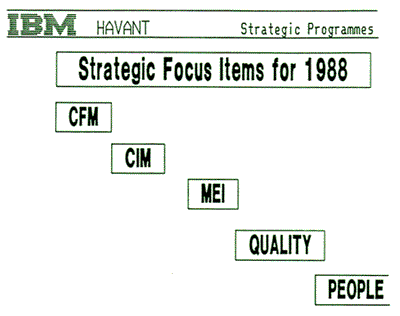
As interactive team and/or individual exercises discuss the extremely important and brutally true management rules and issues covered in this section.
Think about it: How would your manager react to seeing all this? Maybe you want to risk it and show him, or her this part of the program... it might change your, and others' life at work for good...on the other hand don't blame us if you get rejected...
Jump To Top
Design for quality management issues summarized with Japanese
examples by Mr. Robin Truman, Manager, GPT/ Siemens/ Plessey
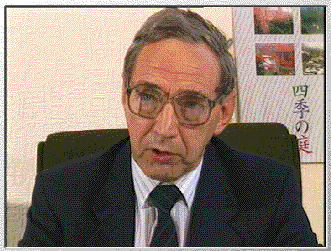
When wieving this program, try to imagine that you are a member of
the concurrent engineering team. As you can see, there are several
different engineering, manufacturing, total quality, information
technology/ computing science, marketing, management and other
expertise represented in such teams.

As an interactive exercise discuss the following complex engineering management issues:
- What are the key success factors of "good quality" hi-tech
management for the engineering and software industry?
- How did this entire CE video package change your views about
the need of stronger teamwork and better integrated systems?
- How would you start to implement some of the learned concepts
and methods in your environment?
- How would you achieve waste reduction?
- How can you make your teams interested in integrated,
collaborative engineering, amanegement and computing?
- What are the benefits? What happens to the savings?
Jump To Top
*********************** End of Tape 20 ***********************
Custom CD, Unique in Each Video CD Pack, Containing Different, Customized Multimedia web-objects for Further Analysis
The goal of this Custom CD is to provide you a unique resource for analyzing the following:
If you are an Engineering Student/ Professional Analyze the following:
There are several objects in this Custom CD that illustrate various engineering solutions. (These objects might be video clips, 3D VR objects, images, or animations, or others). As an exercise, analyze each object/ solution carefully as follows:
- Analyze the needs and the requirements, the demonstrated processes, methods and systems they try to, or have to satisfy.
- Analyze the actual methods presented. Find the core methodologies, the mathematical models, the underlying engineering (and/or other) science foundation (i.e. How does it work?).
- Analyze the technologies involved. (How is science turned into a practical solution/ engineering and/or computing technology?)
- Analyze potential alternative solutions.
- Analyze the benefits and the disadvantages.
- Design alternative methods, processes based on what you have experienced/ seen, and learned.
- Work in a multi-disciplinary team and exchange ideas, if you can.
- Understand the boundaries as well as the tremendous potential of new ideas and developments by working on the selected object/ component/ solution. (Realize that in order to survive and win, you must add value).
At various levels of this virtual product/ process analysis focus on one or more of a variety of different issues, we call them 'views', including the following:
- Requirements/ needs analysis view
- Product/ process design view
- Manufacturing / assembly view
- System integration view
- Networking/ Internet view
- Software engineering view
- Total quality view
- Engineering management view
- Maintenance view
- Environmental view
- Sustainability view
- Operator training and customer support view
- Ergonomics/ Human factors view
- Marketing view, and others.
Document your findings.
If you are an IT/ Computing Science student or professional, analyze the following:
There are several objects in this Custom CD that illustrate various software engineering solutions. (These objects might be video clips, 3D VR objects, images, or animations, or others). As an exercise, analyze/ describe each object/ solution carefully as follows:
- Describe each object/ component as if you were creating an object-oriented database. (As an example, create a group of attributes, that can become fields, such as an identifier, name, size, etc., then consider other attributes and behavior related information, e.g. disk drive (capacity), CPU (speed), motor (RPM, Revolutions Per Minute), and others).
- Analyze the needs and the requirements, the demonstrated processes, methods and systems they try to, or have to satisfy.
- Analyze the actual methods presented. Find the core methodologies, the mathematical models, the underlying IT, computer science foundation (i.e. How does it work?).
- Analyze the technologies involved. (How is science turned into a practical solution/ computing technology?)
- Analyze potential alternative solutions.
- Analyze the benefits and the disadvantages.
- Design alternative methods, processes based on what you have experienced/ seen, and learned.
- Work in a multi-disciplinary team and exchange ideas, if you can.
- Understand the boundaries as well as the tremendous potential of new ideas and developments by working on the selected object/ component/ solution. (Realize that in order to survive and win, you must add value).
Document your findings.
If you are a Management student or professional, analyze the following:
There are several objects in this Custom CD that illustrate various engineering solutions. (These objects might be video clips, 3D VR objects, images, or animations, or others). As an exercise, analyze each object/ solution carefully as follows:
- Analyze the needs and the requirements, the demonstrated processes, methods and systems they try to, or have to satisfy (from a management perspective, e.g. the selected object is trying to virtually demonstrate a product, or process).
- Analyze the technologies involved. (How is science turned into a practical solution/ engineering and/or computing technology?)
- Analyze potential alternative solutions.
- Analyze the benefits and the disadvantages.
- Design alternative methods, processes based on what you have experienced/ seen, and learned.
- Work in a multi-disciplinary team and exchange ideas, if you can.
- Understand the boundaries as well as the tremendous potential of new ideas and developments by working on the selected object/ component/ solution. (Realize that in order to survive and win, you must add value).
Document your findings.
Jump To Top
![]() Additional
reading on Object Oriented Concurrent (hardware and software)
Engineering: as a new development, view the free, electronically
published R&D journal, ADAM with IT
(Advanced Design And Manufacturing with Information Technology) at
this web site, as well as enjoy the hotlinks to other web sites via
ADAM's WebCorner; both just a click
away...
Additional
reading on Object Oriented Concurrent (hardware and software)
Engineering: as a new development, view the free, electronically
published R&D journal, ADAM with IT
(Advanced Design And Manufacturing with Information Technology) at
this web site, as well as enjoy the hotlinks to other web sites via
ADAM's WebCorner; both just a click
away...














